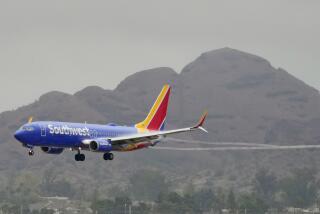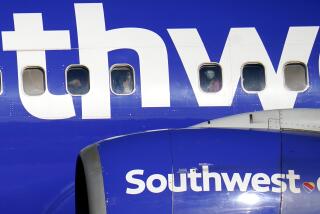Many passengers dislike airlines’ ‘slim-line’ seats
- Share via
“Slim-line” seats, with thinner seat-back cushions, are increasingly popular with airlines because they weigh less and help squeeze more passengers into a plane.
But the seats may not be so popular with passengers.
A new survey by the travel website TripAdvisor shows that many passengers who have tried slim-line seats are not fans.
In the survey of 1,391 travelers, the website found that nearly half weren’t sure whether they had sat in slim-line seats. But of those who said they had tried the seats, 83% said they were less comfortable than traditional seats, 8% said the slim-line seats were more comfortable, and 9% said they couldn’t tell the difference.
Delta Air Lines is the latest of several major carriers to announce plans to install slim-line seats. Delta spokesman Paul Skrbec said the TripAdvisor survey was lacking because it didn’t ask passengers which airlines they flew when they tried the seats. The airline’s internal surveys show passengers like Delta’s slim-line seats, he said.
United, Alaska, Southwest and Spirit are among the other major airlines that have installed slimmer, lighter seats in the last few years.
At United, internal passenger surveys show that the slim-line seats get higher ratings several months after being installed, suggesting the seats get more comfortable over time, airline spokesman Rahsaan Johnson said.
Among the critics of cramped cabins is Sen. John McCain (R-Ariz.), who fired off a tweet last week about his flight to Washington from Phoenix.
“Are you as frustrated as I am that the airlines keep moving the rows of seats closer and closer together?” he said.
Business travelers grab quick bites
Business travel has rebounded from the Great Recession, but lots of travelers remain frugal when spending company money on the road.
That was one of the findings of a new report that analyzed millions of business travel expense reports.
For breakfast, the most frequent eatery for business travelers was Starbucks — 14% of travelers bought food from the coffee shop, spending an average of $8.44 per meal, according to an analysis for the last three months of 2013 by Certify, a travel and expense report management company in Portland, Maine. The company processed more than 15 million expense reports and receipts in 2013, worth about $4.5 billion.
For lunch and dinner, the most frequent expense report was for the fast-food giant McDonald’s, for an average lunch cost of $7.19, and $7.47 for dinner, the report said.
Certify’s chief executive, Bob Neveu, said the report makes sense because fast-food and quick-service eateries are speedy and convenient and usually offer wireless Internet access.
“Most people are traveling individually, and they are out for the week trying to get something fast, convenient and consistent that is within their company policy,” he said.
Airport installs pot-disposal boxes
Colorado Springs Airport recently installed three green metal containers in the terminal where travelers can deposit marijuana, which is legal to buy in Colorado but banned in the airport.
Sorry, but the airport is not taking job applications for pot container attendants.
With recreational marijuana now on sale in Colorado, Denver International and Colorado Springs airports have made it clear that travelers cannot bring pot through their facilities. Even medical marijuana is forbidden.
But the folks at the Colorado Springs airport, about 70 miles south of Denver, don’t want travelers to dump bags of overlooked pot into the terminal trash bins. For that reason, the airport has installed “amnesty boxes.”
A spokesman for the airport said the boxes will be monitored 24 hours a day, with Colorado Springs police responsible for emptying the boxes and destroying any drugs.
More to Read
Inside the business of entertainment
The Wide Shot brings you news, analysis and insights on everything from streaming wars to production — and what it all means for the future.
You may occasionally receive promotional content from the Los Angeles Times.










